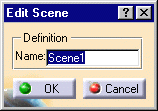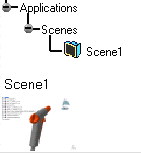
|
This task shows you how to create
scenes.
Scenes enable you to:
- work on the evolution of an assembly in a separate window from the
actual assembly and to impart updates to the assembly as you see fit.
- save a copy of an assembly in a separate window, work on the
evolution of that assembly directly on the assembly, and to revert to the
saved copy if you are not satisfied with the modifications (in this
usage, modifications can be replicated in the assembly using the command
Applying a Scene in an Assembly.
You can modify the following attributes either in the scene or in the
assembly without the modifications being replicated in the other:
- the viewpoint
- the graphical attributes of the components
- the "show" or "hide" state of the components
- the "active" or "not-active" state of the components
|
 |
Overloading of
graphical attributes and show / no show state is limited to Products, i.e.
these modifications are not replicated between scene and assembly for
Products, however, for parts and models, these modifications will be
replicated (modifications on parts and models are always replicated in both
directions).
|
| |
The modification of component
position is treated as follows:
- modification of component position in the assembly is replicated in
the scene as long as the components are synchronized for this scene
- modification of component position in the scene is not
replicated in the assembly and also has the effect of de-synchronizing
all components having the same parent as the moved product
Scenes are identified by name in the specification tree and by a
graphical representation in the geometry area. |
|
When you create a scene, the data
that will constitute the scene is a function of the current selection in
the specification tree. There are three different possibilities:
- if no element is selected in the specification tree or if the
selected object in the specification tree is the root product, then the
newly created scene will include the data of the entire assembly
- if a sub-product of the assembly is selected in the specification
tree, then the newly created scene will include only the data of that
sub-product
- if an existing scene is selected in the specification tree, then the
newly created scene will be a copy of that scene
|
|
The following operations are not
allowed in scene context:
- add
- remove
- replace
- cut
- delete
- paste
|

|
Constraints are not currently
managed by scenes, i.e. creation or modification of constraints in an
assembly are always replicated in the scene, even if the assembly and the
scene are desynchronized, however the visual consequences of the
application of the constraint in the assembly are not replicated.
|

|
Note that you can change the scene
background color at any time using Tools->Options-> Digital Mockup->
DMU Navigator. Please refer to Customizing DMU Navigator Settings.
|

|
Open a new CATProduct document and
insert the following sample model files: (they are to be found in the
online documentation folder under cfyug\samples).
ATOMIZER
BODY1
BODY2
LOCK
NOZZLE1
NOZZLE2
REGULATOR
TRIGGER
VALVE
REGULATION_COMMAND
|

|
Note: Creating scenes from
components multi-selection is not supported. |

|
1. |
Click the Create Scene icon
 . .
The Edit Scene dialog box and a scene representation in the document window
are displayed. |
|
|

 |
|
2. |
Click Ok to end the scene
creation.
You are now in a scene window: The background color turns to green.
Scene 1 is identified in the specification tree. |
|
|
|
|
3. |
Perform the required
modifications. For instance modify:
- viewpoint
- graphical attributes
- show-no show |
|
|
Within a scene, click the Reset selected
products icon
 to reposition the components as they were in the initial product. Note that
color attributes and the show-hide specification are not taken into account
when using the Reset selected products icon.
to reposition the components as they were in the initial product. Note that
color attributes and the show-hide specification are not taken into account
when using the Reset selected products icon. |
|
4. |
Click
the Exit From Scene icon
 to swap to the initial window.
to swap to the initial window.
The scene is updated to reflect any changes made.
|
|
|
 |
|
5. |
Double-click Scene 1 either in the
specification tree or in the geometry area to swap to the scene window. |
|
6. |
Create as many scenes as needed. |

|
|
Note that the scene stamp found at
the bottom-left of the DMU Navigator window is for indicative purposes
only. It is updated only when you exit the scene. |

|
|
Deactivating View -> Scene Specification
Visible in the menu bar removes the scene representation and
lets you use the entire screen for the product. You can also use the F4 key
to toggle more quickly. |

|


